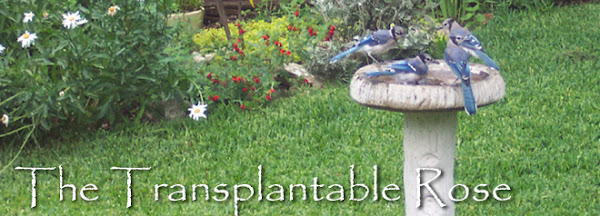Every month Carol of
May Dreams Gardens invites us to share what's in bloom. She thought of this idea back in January of 2007 - meaning some of us are close to the end of Year Three and you've become familiar with most of our plants.
So for this third edition of November Garden Bloggers Bloom Day I decided it could be fun not only to show you what's in flower, but to show you how each plant fits into the garden as a whole. Let's wander around, following the numbers on this rough and simplified map. - it gets a little bigger if you click:

The bed near the front walk is
#1 - here's
Rosa mutabilis in bud and bloom, sending up new shoots.

A few leaves from the whitebud have fallen on a clump of Creeping phlox. It only bloomed once a year in Illinois, but decorates the edges of this bed in both spring and fall. The Yellow Bulbine is trying to take over the whole bed.

Cross the driveway to a bed anchored by three Spiraeas,
#2. I like how the pink cuphea and a fragrant mistflower mix it up - a Red Admiral butterfly approves.

The Pink Entrance Bed,
#3, has whites and purples and blues, too - like this blue-violet Duranta. Can you see that branch with different leaves? It's the 'Rumba' weigela - still alive after the summer of 2009!

There is plenty of Pink in the Pink Entrance bed, including this froth of pink Gaura backed by a fading 'Belinda's Dream' rose. This is the only open Belinda flower, but more buds are swelling.

Let's go toward the Garden Gate - first passing the fuzzy purple Mexican Bush Sage at the corner of the garage,
#4, with colors even more intense than at October GBBD.
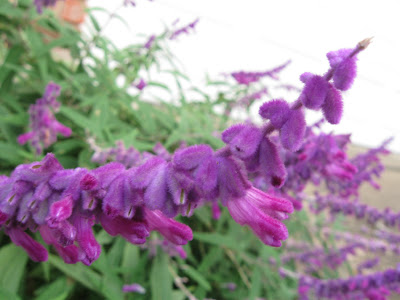
Once through the gate we're inside the privacy fence passing the NE fence border
#5. Salute the
Salvia madrensis, but you'll have to look up to do it.... the wooden fence is 6-feet tall. It was just starting in October and is now in full bloom.
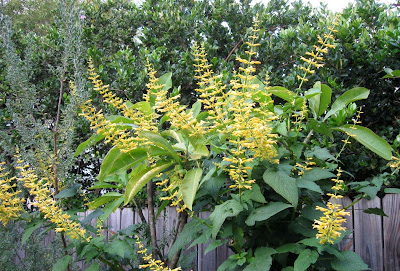
Buttery yellow 'Julia Child' rose grows in this border - also displaying only one rose today, and saving buds for later.
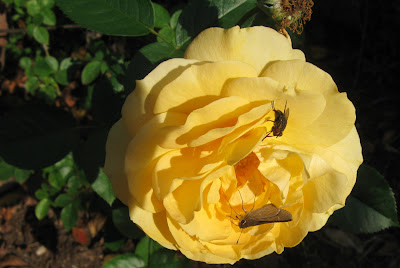
While we walk the grass path you'll see yellow glowing on both sides - in the triangle at right, Bed
# 6, the Mexican Mint Marigold is at its peak with
Russelia equisetiformis, Firecracker plant adding a touch of orange
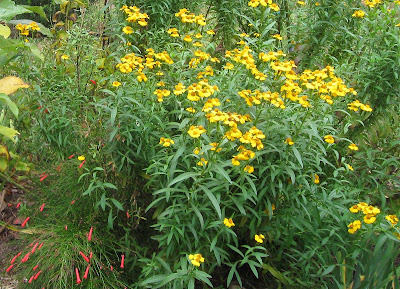
I've planted both the sunny fence border and this first triangle bed with shades of yellow & blue, with lots of white and touches of orange. I've called this Blue Butterfly flower
Clerodendrum ugandense until now-
Pam/Digging showed it with the current name,
Rotheca myricoides 'Ugandense', in a recent post. But an assortment of clunky names can't make the flower any less lovely.

On to
#7 Back in the corner of the vegetable plot is a raised planter with an old-fashioned Rose of Sharon bush and a yellow mum below. I used to hate the word 'mums', but at least I can remember it - had to look up
Dendranthema x grandiflora, Prophet Series 'Yellow". This mum was here when we moved in, still had the tag.

The other day I dug up and divided a clump of cannas, replanting some of them and setting aside the other half for my friend Ellen. Until the pecan leaves fall the vegetable garden is in dense shade so I plopped Ellen's cannas into a big pot and stuck them in the abandoned tomato plot. One of her plants had an opened bud - since they're still here this counts as
my bloom, right?

This time let's walk back between the triangle beds...the path is still "grass" now, but we have plans for granite. On the obelisk in bed
#6 the Blue Pea vine has more pods than flowers but what's there is cherce*. (*Tracy & Hepburn,
Pat & Mike)
The tropical milkweed is as pretty in bud as in bloom, and the Mexican Mint Marigold shows through the network of vines from the other side.

On the south side of the path at Triangle
#8 there's are tiny larkspur and cilantro seedlings and various annual salvia seedlings but the only flowers are on the dependable white reseeding
Zinnia linnearis. The green shrub is a dwarf Greek myrtle.

Bed
# 9 is the best spot in the whole garden, offering morning sun, afternoon shade, shelter from hail and cold north winds, access to the hose faucet and attention from the gardeners who use the back door. Currently blooming in this desirable location are the pink mouse-faced cuphea and the big Brugmansia/Angel Trumpet. The Meyer's Improved lemon ripens a handful of beautiful fruit.

Before we head for the patio a close look reveals a beautiful green spider who has captured a bee.

On the South end of the patio,
#10, impatiens bloom in one pot, Sambac Jasmine is budded in another and a potted Meyer's lemon promises Cranberry-Lemon relish for Thanksgiving.

The arch connecting the patio to the grassy area under the pecans is covered by a Coral Honeysuckle in both beautiful bloom

And delicate, graceful bud.

Cross the grass to the South fence where
#11 was designed as a hummingbird bed with lots of Salvias. Right now Gregg's salvia, Pineapple sage,
Salvia coccinea, Salvia 'Black & Blue',
Salvia guaranitica, and
Salvia farinacea each have a few flowers in red and blue, but when the
Cuphea llavea/Bat-faced cuphea combines these two colors the result is so cute it gets the photo.
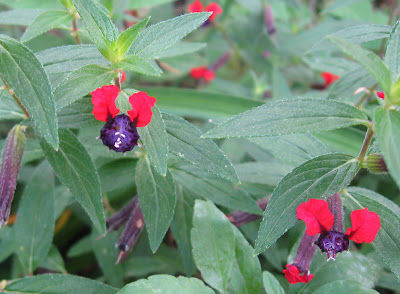
Enlarging one batface on a different photo surprised me - How old is this plant? It looks like it's growing a beard:
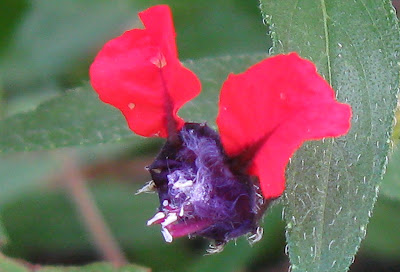
The hummingbird bed merges with a shady long bed as you move to the right - first bats, now toads? The Toadlily plant is half the size it was last fall, but it survived in shade and managed to push out a few spotted flowers.

As we head toward the garden shed, stop to look up at my beloved Loquat, grown from a seedling, now flowering and covered in butterflies 12-feet up in the air. The buds are just beginning to open on the lower branches.

The sasanqua Camellia started blooming this week in the bed along the garden shed,
#12.
A new shrub might have died but I planted it in 2004. Being established in filtered shade meant that the camellia not only survived but made a few dozen buds and flowers. Austinites on Hill Country terrain don't usually succeed with camellias, but they're not uncommon in my part of Austin.
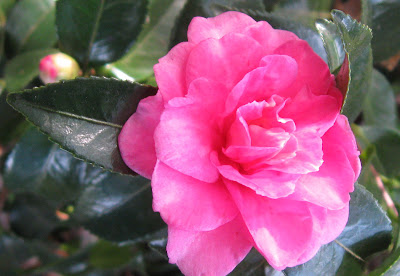
A few feet away is the Bulb Bed,
# 13, jammed with leftover Christmas amaryllis/Hippeastrum, with dollar store Daffodils, with non-blooming Agapanthus, old Easter lilies, freesias and other bulbs picked up on sale. One pot of
Oxalis regnellii 'Atropurpurea' , sometimes called Purple Shamrock, has been divided over and over and appears in a dozen clumps front and back. The flowers seem paler here than in real life.

Through the arch to
#14 - where more dark purple comes from a Potato vine in a blue pot, annual Impatiens act like perennials in this sheltered spot and green Oxalis bloom white.

The wooden privacy fence surrounds this little area and separates the front and back yards. I've heard this kind of space called a Dogleg, but after we cleaned out the junk we christened it the Secret Garden. When May Dreams Carol visited my garden I joked that the
secret was that I would never let the Air-Conditioner appear in any photos.

But here's the real secret of the Secret Garden: Three Sweet Olive/Osmanthus shrubs are spaced around the south end of the house, with inconspicuous flowers wafting a lovely scent over the whole back yard. A visitor might wonder where the fragrance came from, until I tell them the Secret.
The complete GBBD list with my best shot at the botanical names
will appear is now up at
Annie's Addendum.
To see more than 100 Bloom Day posts from around the world go to
Carol's roundup at May Dreams.
 We watched it decline and die inch by inch this summer and by the end of October knew it had to come down. Even before the saw came out of the shed, I'd decided on a replacement.
We watched it decline and die inch by inch this summer and by the end of October knew it had to come down. Even before the saw came out of the shed, I'd decided on a replacement. Philippine violets do well here and so do Oxblood lilies, paperwhites and small daffodils like this unnamed paperwhite above that opened over the weekend.
Philippine violets do well here and so do Oxblood lilies, paperwhites and small daffodils like this unnamed paperwhite above that opened over the weekend. The trunk came down but the peach roots will take a long time to disintegrate. After the Arizona Ash was removed from the front yard in 2007, we helped the process along by piling on mulch & compost after the stump was ground and sinking container plants on top of the mulch. The water, fertilizer and compost that seeped through seemed to help the roots decompose more quickly. We'll see if a container and mulch will work on peach roots, too.
The trunk came down but the peach roots will take a long time to disintegrate. After the Arizona Ash was removed from the front yard in 2007, we helped the process along by piling on mulch & compost after the stump was ground and sinking container plants on top of the mulch. The water, fertilizer and compost that seeped through seemed to help the roots decompose more quickly. We'll see if a container and mulch will work on peach roots, too. The shopping word in the plan was "container" - off to the nearby Countryside Nursery we went, in search of an attractive pot to hold the camellia. Countryside carries an assortment of natural and organic products like Medina and Cottonbur Compost. We buy plants there - it's where I found the 'Julia Child' rose you've seen in bud and bloom. And we buy pots there, like the big blue pot in the secret garden - still full of dark purple potato vine as winter approaches.
The shopping word in the plan was "container" - off to the nearby Countryside Nursery we went, in search of an attractive pot to hold the camellia. Countryside carries an assortment of natural and organic products like Medina and Cottonbur Compost. We buy plants there - it's where I found the 'Julia Child' rose you've seen in bud and bloom. And we buy pots there, like the big blue pot in the secret garden - still full of dark purple potato vine as winter approaches. Out on the lot we chose a slightly smaller version of the blue pot, liking it even more after Philo brought it up to the counter and the sale price was 20% off the label. I found more treasure inside the building. Every year I remind myself to order Hyacinthoides hispanica, so I can try to copy the Spanish Bluebell display at Zanthan Gardens. But once again I didn't order any - what a lucky break to find Spanish Bluebell bulbs on the rack at Countryside!
Out on the lot we chose a slightly smaller version of the blue pot, liking it even more after Philo brought it up to the counter and the sale price was 20% off the label. I found more treasure inside the building. Every year I remind myself to order Hyacinthoides hispanica, so I can try to copy the Spanish Bluebell display at Zanthan Gardens. But once again I didn't order any - what a lucky break to find Spanish Bluebell bulbs on the rack at Countryside! Back home I found a black plastic nursery pot of the right size. Philo sawed off the top few inches so it could fit inside the ceramic pot as a liner. That should make it easier when it's time to transplant the camellia into the ground. As always, I cut pieces of roll window screen to cover the holes in both ceramic pot and plastic inner pot. John Dromgoole says the screen helps keep ant colonies and pillbugs from invading containers. I removed the camellia from its starter pot and planted it with Lady Bug Brand Rose Magic soil mixed with extra peat, watering it in with Maxicrop Seaweed w/Iron. ( Products are named not because anyone is paying me but because my blogs have replaced my memory. If this idea works the names will remind me exactly how it was done.)
Back home I found a black plastic nursery pot of the right size. Philo sawed off the top few inches so it could fit inside the ceramic pot as a liner. That should make it easier when it's time to transplant the camellia into the ground. As always, I cut pieces of roll window screen to cover the holes in both ceramic pot and plastic inner pot. John Dromgoole says the screen helps keep ant colonies and pillbugs from invading containers. I removed the camellia from its starter pot and planted it with Lady Bug Brand Rose Magic soil mixed with extra peat, watering it in with Maxicrop Seaweed w/Iron. ( Products are named not because anyone is paying me but because my blogs have replaced my memory. If this idea works the names will remind me exactly how it was done.)  I hope the Camellia buds open white as promised and I hope the plant can live and grow in the pot for a couple of years. By then the roots may be rotted and the ground mellowed enough to be ready to receive it. Then will come the fun of thinking up something new to plant in the blue-green pot.
I hope the Camellia buds open white as promised and I hope the plant can live and grow in the pot for a couple of years. By then the roots may be rotted and the ground mellowed enough to be ready to receive it. Then will come the fun of thinking up something new to plant in the blue-green pot.
